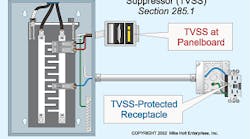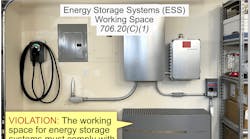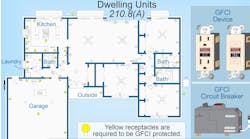The NEC distinguishes between surge arresters and transient voltage surge suppressors (TVSSs), yet both provide surge protection. What's the difference between them? Surge arresters generally apply to only the supply side (line side) of the meter (280.22), whereas TVSS devices generally apply to only the load side (285.21). While some devices are listed for use in either location, most surge protection devices are designed for use in only one or the other. Thus, the NEC devotes a different Article to each.
Art. 280 applies to devices listed as surge arresters, and Art. 285 (Fig. 1) applies to TVSS devices. Neither Article applies to devices that incorporate a surge protection device, such as a cord-and-plug connected surge protection unit, a receptacle, or an appliance that has integral surge protection. Comparing surge arresters to TVSS devices yields some useful insights and clarifies a confusing issue. For this discussion, let's start with surge arrester basics.
Surge arresters.
Transient voltage surges — sometimes called spikes — are short-term deviations from a desired voltage level, or signal, that can cause equipment malfunction or damage. A transient surge on a 60-Hz AC sine wave is very brief in duration — it can usually be measured in microseconds — and the surge voltage is much higher than the AC line voltage. Equipment driven by microprocessors is especially vulnerable to transient surges, making some kind of protection necessary.
Surge protection devices (SPD) are designed to reduce potentially damaging short-duration transients present on utility power lines, data networks, telephone lines, closed-circuit and cable TV feeds, and any other power or control lines connected to electrical equipment.
A surge arrester limits surge voltages by discharging or bypassing surge current. It prevents continued flow of follow current without sacrificing itself in the process, so it can repeatedly provide the intended protection. An example of a surge arrester is a spark gap device, which discharges an overvoltage into the ground.
It doesn't matter whether you install surge arresters inside or out, but they must be inaccessible to unqualified persons, unless listed for installation in accessible locations (280.11). The physical routing of the leads is crucial. Keep the leads as short and straight as possible (280.12), or your installation is in danger of surge energy that bypasses the leads or flashes from the leads to nearby equipment. Where you use a surge arrester at a point on a circuit, you must connect to each ungrounded conductor (280.3).
When installing surge arresters at services of less than 1,000V, 280.21 requires you to connect the grounding conductor for the arrester to the grounded (neutral) service conductor, grounding electrode conductor, grounding electrode for the service, or equipment grounding terminal in the service equipment.
While 280.22 permits you to install surge arresters on the load side for services of less than 1,000V (if listed for such application), it usually makes more sense to install a TVSS device at that location because of how it accomplishes protection. That's where Art. 285 comes into play.
Similarities.
TVSS devices are similar to surge arresters in the following ways.
-
The TVSS prevents continued flow of follow current without sacrificing itself in the process (285.2 or 280.2).
-
You can locate TVSSs inside or outside (285.11 and 280.11). As with surge arresters, you must make these devices inaccessible to unqualified persons, unless they're listed for installation in accessible locations (285.11 actually appears in the 2002 Code under Art. 285 Part II as “285.1” by mistake).
-
You can connect the device between any two conductors — ungrounded conductor, grounded conductor, and grounding conductor [280.22 and 285.21(C)].
-
As with surge arresters, the physical routing of the leads is crucial. Keep the leads as short and straight as possible (285.12 and 280.12). Where you use a surge arrester at a point on a circuit, you must connect to each ungrounded conductor (285.4 and 280.3).
-
Grounding conductors may not be run in metal enclosures unless the metal raceway is bonded to the grounding conductor at both ends (280.25 and 285.25).
-
Line and ground connecting conductors may not be smaller than 14 AWG copper or 12 AWG aluminum [280.22 and 285.21(B)].
-
When installing either device, you must ensure that no more than one conductor terminates on a terminal, unless the terminal is identified otherwise [110.14(A)].
Key differences.
While a surge arrester discharges or bypasses surge currents, a TVSS device shunts the current and clamps the voltage. It will clamp at a given voltage — depending on how much surge current it sees — and provide a “tighter” level of protection than a surge arrester. Because of the materials used to construct a TVSS, however, selection (see “TVSS Selection” on page 93) is a major factor in developing an effective, reliable, and inexpensive TVSS application. The limitations of these materials are why 285.3 doesn't permit the following uses:
-
Circuits exceeding 600V (you must use a surge arrester instead).
-
Ungrounded electrical systems.
-
Where the rating of the TVSS is less than the maximum phase-to-ground voltage at the point of connection.
The devices also differ in location requirements. While the limiting factor for surge arrester location is the maximum continuous phase-to-ground power frequency voltage available at the point of application (280.4), the limiting factor for TVSS location is the short-circuit current rating marked on the TVSS device (285.6). You can locate a TVSS device only on the load side of the service equipment, unless it's also listed as a surge arrester (285.21) (Fig. 2). In most cases, a TVSS will be listed for load side applications only. You can connect a load-side-only-rated TVSS device anywhere on the premises wiring system, but not on the line side of the service disconnect overcurrent device. This holds true in similar situations: You can't install a load-side-only-rated TVSS device on the line side of the first overcurrent device in a feeder-supplied structure or a separately derived system.
Whether you select a TVSS or a surge arrester depends mostly on what energy level you're dealing with, assuming both devices meet the Code requirements. Generally, you will use a surge arrester on the line side of the service and a TVSS device at some point on the load side of the first protection device at the service. Understanding their similarities and differences will help you develop a cost-effective, Code-compliant surge protection design.
TVSS Selection
The more precise protection of a TVSS comes with a caveat: A TVSS generally can't handle as much energy as can a surge arrester. This doesn't mean a TVSS is failure-prone — far from it. It just means you must select a TVSS rated for the appropriate location, and apply a protection scheme that makes best use of TVSS's capabilities. You have to consider such factors as the maximum continuous operating voltage. You need a good idea of the level of current as well as the magnitude and duration of overvoltages at the suppressor location. Then you must look at TVSS devices that match that environment. Beware of the “bigger is better” syndrome in relation to TVSS device ratings — it's most important to match the device to the application. A good reference is NEMA LS 1-1992, Standard for Low-Voltage Surge Suppression Devices.
Are you still confused by the Code? For additional information on Code-related topics please visit www.mikeholt.com or send an e-mail directly to the author at [email protected].




